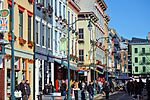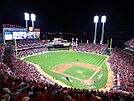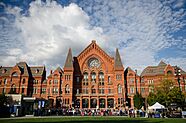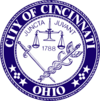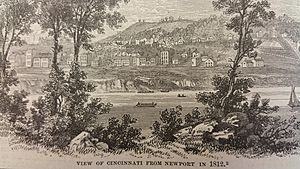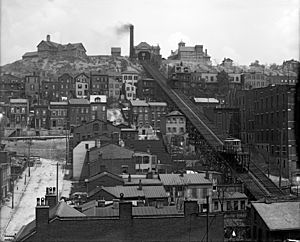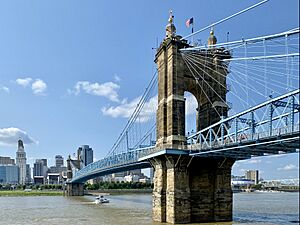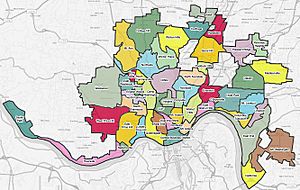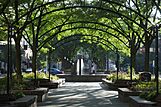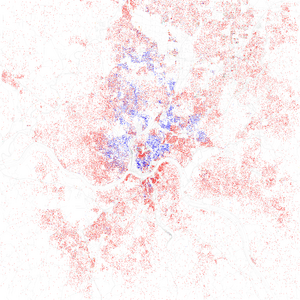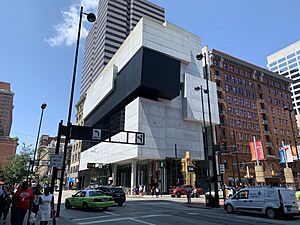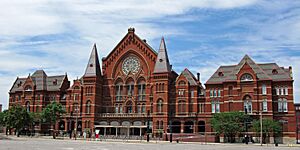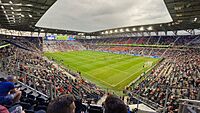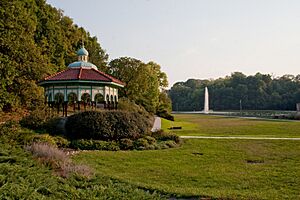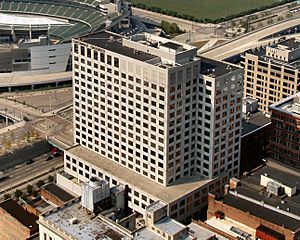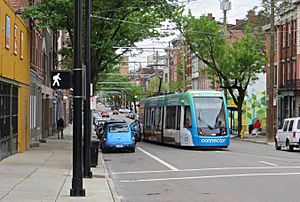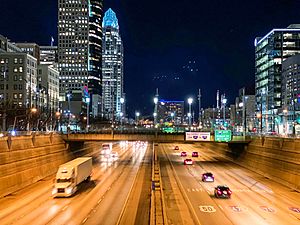Cincinnati facts for kids
Quick facts for kids
Cincinnati
|
|||||
|---|---|---|---|---|---|
|
|||||
| Nicknames:
The Birthplace of Professional Baseball, The Queen of the West, Athens of the West, Cincy, Little Paris, Paris of America, Porkopolis, The Queen City, The Nati
|
|||||
| Motto(s):
Juncta Juvant (Latin)
"Strength in Unity" |
|||||
| Country | |||||
| State | |||||
| County | Hamilton | ||||
| Settled | 1788 | ||||
| Incorporated (town) | January 1, 1802 | ||||
| Incorporated (city) | March 1, 1820 | ||||
| Named for | Society of the Cincinnati and Cincinnatus | ||||
| Government | |||||
| • Type | Mayor–council | ||||
| • Body | Cincinnati City Council | ||||
| Area | |||||
| • City | 79.64 sq mi (206.26 km2) | ||||
| • Land | 77.91 sq mi (201.80 km2) | ||||
| • Water | 1.72 sq mi (4.46 km2) | ||||
| • Metro | 4,808 sq mi (12,450 km2) | ||||
| Elevation | 742 ft (226 m) | ||||
| Population
(2020)
|
|||||
| • City | 309,317 | ||||
| • Estimate
(2023)
|
311,097 | ||||
| • Rank | US: 64th | ||||
| • Density | 3,969.98/sq mi (1,532.81/km2) | ||||
| • Urban | 1,686,744 (US: 33rd) | ||||
| • Urban density | 2,242.2/sq mi (865.7/km2) | ||||
| • Metro | 2,265,051 (US: 30th) | ||||
| • Demonym | Cincinnatian | ||||
| GDP | |||||
| • Cincinnati (MSA) | $157.0 billion (2022) | ||||
| Time zone | UTC−5 (EST) | ||||
| • Summer (DST) | UTC−4 (EDT) | ||||
| ZIP Codes |
452XX, 45999
|
||||
| Area code | 513 and 283 | ||||
| FIPS code | 39-15000 | ||||
| GNIS feature ID | 1086201 | ||||
Cincinnati (![]() i/ˌsɪnsɪˈnæti/ SIN-sih-NAT-ee), also called Cincy, is a big city in Ohio, United States. It is the main city of Hamilton County. The city was started by Europeans in 1788. It is located on the northern side of the Ohio River, where the Licking River joins it. The Ohio River forms the border with Kentucky.
i/ˌsɪnsɪˈnæti/ SIN-sih-NAT-ee), also called Cincy, is a big city in Ohio, United States. It is the main city of Hamilton County. The city was started by Europeans in 1788. It is located on the northern side of the Ohio River, where the Licking River joins it. The Ohio River forms the border with Kentucky.
In 2020, Cincinnati had about 309,317 people living there. This makes it the third-largest city in Ohio. It is also the 64th largest city in the whole U.S. Cincinnati is a major center for business and culture in its larger metropolitan area. This area has over 2.265 million people, making it Ohio's biggest metro area and the 30th largest in the U.S.
In the 1800s, Cincinnati was one of the top 10 largest cities in the U.S. It grew as a busy river town for shipping goods by steamboats. It was a meeting point between the Northern and Southern United States. Many German-speaking immigrants moved here. They helped create many of the city's cultural places. Later, Cincinnati became a center for manufacturing. Because of its beautiful buildings like the Music Hall and Roebling Bridge, people sometimes called it the "Paris of America."
The Cincinnati area has a large economy, ranking 28th in the U.S. and fifth in the Midwest. It is home to several big companies like Kroger and Procter & Gamble. The city also has three professional sports teams: the Cincinnati Reds (baseball), the Cincinnati Bengals (football), and FC Cincinnati (soccer). The University of Cincinnati, founded in 1819, is one of the largest universities in the country.
Contents
History of Cincinnati
How Cincinnati Got Its Name
Two years after the first settlement, called "Losantiville," was founded, Arthur St. Clair changed its name. He was the governor of the Northwest Territory. He renamed it "Cincinnati" to honor the Society of the Cincinnati. This group was made up of officers from the Continental Army who fought in the Revolutionary War. St. Clair was the president of this group.
The Society was named after Lucius Quinctius Cincinnatus. He was a Roman leader who saved Rome from danger. After that, he went back to his farm because he did not want to stay in power. He became a symbol of good citizenship.
Early Days of the City
Cincinnati started in 1788. Mathias Denman, Colonel Robert Patterson, and Israel Ludlow chose a spot on the northern bank of the Ohio River. It was across from the mouth of the Licking River. The first surveyor, John Filson, named it "Losantiville." This name meant "town opposite the mouth of the Licking." On January 4, 1790, Governor St. Clair changed the name to Cincinnati.
In 1811, steamboats began to be used on the Ohio River. This made shipping faster and helped the city's trade grow. Cincinnati became connected to cities like St. Louis, Missouri and New Orleans. On March 1, 1819, Cincinnati officially became a city. It became a big center for processing pork and exporting hay. Between 1810 and 1830, the city's population grew from about 9,642 to 24,831.
Work on the Miami and Erie Canal started in 1825. The first part of the canal opened in 1827, connecting Cincinnati to Middletown. By 1840, the canal reached Toledo.
Railroads were the next important way to transport goods. In 1836, the Little Miami Railroad was started. It aimed to connect Cincinnati to Lake Erie.
During this time, Cincinnati needed more workers. Many Irish and German immigrants arrived in the late 1840s. The city grew quickly, reaching 115,000 people by 1850. People started calling Cincinnati the "Queen City" because of its fast growth and importance.
Growth and Change in the 1800s
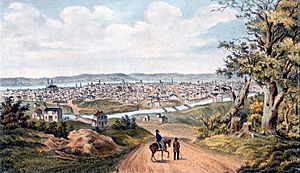
Cincinnati was located between the free state of Ohio and the slave state of Kentucky. This made it an important stop for enslaved people escaping the South. Many people who were against slavery also lived in Cincinnati. It became a popular stop on the Underground Railroad. In 2004, the National Underground Railroad Freedom Center opened in Downtown Cincinnati. It honors the city's role in helping people find freedom.
In 1859, Cincinnati started six streetcar lines. These cars were pulled by horses. By 1872, people could use streetcars to travel within the city. They could also transfer to rail cars to reach communities on the hills. The Cincinnati Inclined Plane Company began taking people to the top of Mount Auburn. In 1889, the streetcar system started using electric streetcars instead of horses.
In 1880, the city government finished building the Cincinnati, New Orleans and Texas Pacific Railway. This railway went to Chattanooga, Tennessee. It was the only railway owned by a city that crossed state lines for a long time.
Cincinnati in the 1900s
At the start of the 1900s, Cincinnati had over 325,000 people. The city built many impressive projects. These included the Ingalls Building (1903), Cincinnati Union Terminal, and the Carew Tower. The Carew Tower was the city's tallest building when it was finished.
Cincinnati handled the Great Depression better than many other large American cities. This was partly because river trade became more important. The Ohio River flood of 1937 was very bad. After the flood, the city built protective walls to prevent future damage.
After World War II, Cincinnati made a plan to improve the city. This led to many modern changes in the downtown area. In the 1950s, Cincinnati's population reached its highest point, with over 509,998 people. Since then, a lot of money has been spent to improve neighborhoods. This includes building safe housing and creating jobs.
Cincinnati Today
In the early 2000s, Cincinnati's population was about 331,285. New sports stadiums were built, like Paycor Stadium (for the Bengals) and Great American Ball Park (for the Reds).
In 2018, MLS announced that FC Cincinnati would join the league. This made it the city's third professional sports team. TQL Stadium, the team's new home, opened in 2021. The 2020 census showed that Cincinnati's population had grown. This was the first time it increased since the 1950 census.
On January 4, 2022, Aftab Pureval became the 70th mayor of Cincinnati.
City Nicknames
Cincinnati has many nicknames. Some common ones are "Cincy," "The Queen City," and "The Queen of the West." Locals often use "Cincy" in everyday talk.
"The City of Seven Hills" comes from an article in 1853. It described seven hills around the city: Mount Adams, Walnut Hills, Mount Auburn, Vine Street Hill, College Hill, Fairmount, and Price Hill. This name refers to ancient Rome, which was also built on seven hills.
"Queen City" was first used in a newspaper in 1819. It was also made famous by a poem in 1854 by Henry Wadsworth Longfellow. He wrote about Cincinnati as "The Queen of the West, In her garlands dressed, On the banks of the Beautiful River."
For many years, Cincinnati was also known as "Porkopolis." This nickname came from the city's large pork industry. Newer nicknames like "The 'Nati" are also used. For example, a local group uses the phrase "Don't Trash the 'Nati" to encourage people to keep the city clean.
Geography and City Layout
Cincinnati is changing a lot with new buildings and projects. One big project is The Banks, which has apartments, shops, and restaurants. It stretches from Great American Ball Park to Paycor Stadium. Smale Riverfront Park is also being built along the river. Billions of dollars have been invested in the city's center. The Cincinnati Bell Connector (a streetcar) started running in 2016.
Cincinnati is located about halfway between Pittsburgh, Pennsylvania and Cairo, Illinois by river. The downtown area is near where the Licking River meets the Ohio River. The city covers about 79.54 square miles (206.0 km2). Most of this is land, with some water. Cincinnati is built on many hills and ridges that look over the Ohio River.
Three smaller towns are completely surrounded by Cincinnati: Norwood, Elmwood Place, and Saint Bernard. Norwood is a business and industrial town. Elmwood Place and Saint Bernard are mostly residential villages.
City Landmarks
Cincinnati has many famous landmarks. Some are known across the country, while others are special to people who live here. These include: Union Terminal, Carew Tower, Great American Tower, Fountain Square, Washington Park, and Great American Ballpark.
Many buildings in Cincinnati are famous for their architecture or history. These include the Carew Tower, the Scripps Center, and the Ingalls Building. The Queen City Square opened in 2011. It is the tallest building in Cincinnati and the third tallest in Ohio.
The Ohio River's flood stage in Cincinnati is 52 feet (16 m). At this level, a special pumping station is turned on. The highest the Ohio River has ever been in Cincinnati was 79 feet 11.875 inches (24.38 m) in 1937. Parts of downtown Cincinnati are protected from floods by the Serpentine Wall at Yeatman's Cove and another flood wall.
Neighborhoods of Cincinnati
Cincinnati has 52 neighborhoods. Many of these used to be separate villages that the city later took over. They often kept their old names, like Walnut Hills and Mount Auburn. Westwood is the neighborhood with the most people. Other important neighborhoods include CUF (where the University of Cincinnati is) and Price Hill.
Downtown Cincinnati is the city's main business area. It includes neighborhoods like Over-the-Rhine, Pendleton, Queensgate, and West End. Over-the-Rhine is one of the largest historic districts in the U.S. Its beautiful brick buildings were built by German immigrants in the late 1800s. This neighborhood has been greatly improved in recent years, with a focus on small businesses.
Cincinnati's Climate
| Weather chart for Cincinnati, Ohio | |||||||||||||||||||||||||||||||||||||||||||||||
|---|---|---|---|---|---|---|---|---|---|---|---|---|---|---|---|---|---|---|---|---|---|---|---|---|---|---|---|---|---|---|---|---|---|---|---|---|---|---|---|---|---|---|---|---|---|---|---|
| J | F | M | A | M | J | J | A | S | O | N | D | ||||||||||||||||||||||||||||||||||||
|
3.3
40
23
|
3.2
44
26
|
4.2
54
34
|
4.5
66
44
|
4.7
75
54
|
4.8
83
62
|
3.8
86
66
|
3.4
85
65
|
3.1
79
57
|
3.4
67
46
|
3.2
54
35
|
3.7
43
28
|
||||||||||||||||||||||||||||||||||||
| temperatures in °F precipitation totals in inches |
|||||||||||||||||||||||||||||||||||||||||||||||
|
Metric conversion
|
|||||||||||||||||||||||||||||||||||||||||||||||
Cincinnati has a climate that is a mix of humid continental and humid subtropical. This means it has four distinct seasons.
Summers are hot and humid. Temperatures often reach 90°F (32°C) or higher. July is the warmest month.
Winters are cold and usually have some snow. January is the coldest month. On average, Cincinnati gets about 22.1 inches (56.1 cm) of snow each winter. The city gets about 42.5 inches (108 cm) of rain each year, with most rain falling in spring. The temperature has ranged from -25°F (-32°C) to 108°F (42°C).
While Cincinnati does not get as much snow as cities near the Great Lakes, there have been some big snowstorms. These include the Great Blizzard of 1978. Strong thunderstorms are common in warmer months. Tornadoes are rare but have happened in the area.
| Climate data for Cincinnati (Cincinnati/Northern Kentucky Int'l), 1981–2010 normals, extremes 1871–present | |||||||||||||
|---|---|---|---|---|---|---|---|---|---|---|---|---|---|
| Month | Jan | Feb | Mar | Apr | May | Jun | Jul | Aug | Sep | Oct | Nov | Dec | Year |
| Record high °F (°C) | 77 (25) |
78 (26) |
88 (31) |
90 (32) |
95 (35) |
102 (39) |
108 (42) |
103 (39) |
102 (39) |
91 (33) |
82 (28) |
75 (24) |
108 (42) |
| Mean maximum °F (°C) | 60.7 (15.9) |
65.3 (18.5) |
75.7 (24.3) |
81.8 (27.7) |
85.8 (29.9) |
91.4 (33.0) |
94.0 (34.4) |
93.4 (34.1) |
89.8 (32.1) |
82.0 (27.8) |
72.7 (22.6) |
62.1 (16.7) |
95.5 (35.3) |
| Mean daily maximum °F (°C) | 38.7 (3.7) |
42.9 (6.1) |
53.2 (11.8) |
64.7 (18.2) |
73.7 (23.2) |
82.1 (27.8) |
85.6 (29.8) |
84.9 (29.4) |
78.1 (25.6) |
66.2 (19.0) |
54.0 (12.2) |
41.6 (5.3) |
63.9 (17.7) |
| Mean daily minimum °F (°C) | 23.0 (−5.0) |
26.0 (−3.3) |
34.0 (1.1) |
43.7 (6.5) |
53.2 (11.8) |
62.0 (16.7) |
66.1 (18.9) |
64.8 (18.2) |
57.0 (13.9) |
45.5 (7.5) |
36.2 (2.3) |
26.6 (−3.0) |
44.9 (7.2) |
| Mean minimum °F (°C) | −1.1 (−18.4) |
4.6 (−15.2) |
14.8 (−9.6) |
26.2 (−3.2) |
37.0 (2.8) |
48.0 (8.9) |
54.3 (12.4) |
53.8 (12.1) |
40.8 (4.9) |
28.7 (−1.8) |
19.3 (−7.1) |
5.4 (−14.8) |
−5.8 (−21.0) |
| Record low °F (°C) | −25 (−32) |
−17 (−27) |
−11 (−24) |
15 (−9) |
27 (−3) |
39 (4) |
47 (8) |
43 (6) |
31 (−1) |
16 (−9) |
0 (−18) |
−20 (−29) |
−25 (−32) |
| Average precipitation inches (mm) | 3.00 (76) |
2.81 (71) |
3.96 (101) |
3.89 (99) |
4.93 (125) |
4.03 (102) |
3.76 (96) |
3.41 (87) |
2.63 (67) |
3.30 (84) |
3.43 (87) |
3.37 (86) |
42.52 (1,080) |
| Average snowfall inches (cm) | 6.5 (17) |
6.5 (17) |
3.0 (7.6) |
0.5 (1.3) |
trace | 0 (0) |
0 (0) |
0 (0) |
0 (0) |
0.4 (1.0) |
0.4 (1.0) |
4.8 (12) |
22.1 (56) |
| Average precipitation days (≥ 0.01 in) | 12.4 | 11.6 | 12.5 | 12.7 | 12.8 | 11.5 | 10.6 | 9.1 | 7.7 | 8.4 | 10.6 | 12.5 | 132.4 |
| Average snowy days (≥ 0.1 in) | 6.5 | 5.4 | 2.4 | 0.6 | 0.1 | 0 | 0 | 0 | 0 | 0.1 | 0.8 | 4.9 | 20.8 |
| Average relative humidity (%) | 72.2 | 70.1 | 67.0 | 62.8 | 66.9 | 69.2 | 71.5 | 72.3 | 72.7 | 69.2 | 71.0 | 73.8 | 69.9 |
| Mean monthly sunshine hours | 120.8 | 128.4 | 170.1 | 211.0 | 249.9 | 275.5 | 277.0 | 261.5 | 234.4 | 188.8 | 118.7 | 99.3 | 2,335.4 |
| Percent possible sunshine | 40 | 43 | 46 | 53 | 56 | 62 | 61 | 62 | 63 | 55 | 39 | 34 | 52 |
| Source: NOAA (relative humidity and sun 1961–1990) | |||||||||||||
People of Cincinnati
| Historical population | ||
|---|---|---|
| Year | Pop. | ±% |
| 1800 | 850 | — |
| 1810 | 2,540 | +198.8% |
| 1820 | 9,642 | +279.6% |
| 1830 | 24,831 | +157.5% |
| 1840 | 46,338 | +86.6% |
| 1850 | 115,435 | +149.1% |
| 1860 | 161,044 | +39.5% |
| 1870 | 216,239 | +34.3% |
| 1880 | 255,139 | +18.0% |
| 1890 | 296,908 | +16.4% |
| 1900 | 325,902 | +9.8% |
| 1910 | 363,591 | +11.6% |
| 1920 | 401,247 | +10.4% |
| 1930 | 451,160 | +12.4% |
| 1940 | 455,610 | +1.0% |
| 1950 | 503,998 | +10.6% |
| 1960 | 502,550 | −0.3% |
| 1970 | 452,525 | −10.0% |
| 1980 | 385,460 | −14.8% |
| 1990 | 364,040 | −5.6% |
| 2000 | 331,285 | −9.0% |
| 2010 | 296,943 | −10.4% |
| 2020 | 309,317 | +4.2% |
| 2023 | 311,097 | +0.6% |
| Source: U.S. decennial census 1810–1970 1980–2000 2010–2020 2023 (est) |
||
| Demographic profile | 2020 | 2010 | 2000 | 1990 | 1970 | 1950 |
|---|---|---|---|---|---|---|
| White | 50.3% | 48.2% | 53.0% | 60.5% | 71.9% | 84.4% |
| —Non-Hispanic | 48.2% | 48.1% | 51.7% | 60.2% | 71.4% | n/a |
| Black or African American | 41.4% | 44.8% | 42.9% | 37.9% | 27.6% | 15.5% |
| Hispanic or Latino (of any race) | 4.2% | 2.8% | 1.3% | 0.7% | 0.6% | n/a |
| Asian | 2.2% | 1.8% | 1.5% | 1.1% | 0.2% | 0.1% |
In 1950, Cincinnati's population was its largest ever, with 503,998 people. After that, the population went down in every census until 2010. This was partly because many jobs in factories were lost. More recently, the population has started to grow again. The 2020 census showed 309,317 people, which was a 4.2% increase from 2010. This was the first time the population increased since 1950.
In 2020, there were 309,317 people living in Cincinnati. About 50.3% were White, 41.4% were African American, and 4.2% were Hispanic or Latino (of any race). The average age in the city was 32.5 years.
The larger Cincinnati metropolitan area had about 2,265,051 people in 2022. This makes it the 30th largest metro area in the country. It includes several counties in Ohio, Kentucky, and Indiana.
Economy of Cincinnati

The Cincinnati area has the 28th largest economy in the United States. It is the fifth largest in the Midwest. In 2016, it was the fastest-growing economy in the Midwest. The total value of goods and services produced in the region was $157.0 billion in 2022.
The cost of living in Cincinnati is about 8% lower than the national average. The average home price is $158,200. In September 2022, the unemployment rate was 3.3%, which is lower than the national average.
Several very large companies have their main offices in Cincinnati. These include Kroger (a grocery store chain), Procter & Gamble (which makes many household products), and Fifth Third Bank. General Electric also has a major operations center here. Kroger is the largest employer in the city, with over 20,000 local employees. Other big employers are Cincinnati Children's Hospital and the University of Cincinnati.
Arts and Culture
Community Life
Cincinnati was settled by early American pioneers. For a long time, it was the most important city in Ohio. This earned it the nickname "chief city of Ohio" in 1879. Many books have been written about the city's history and its people.
Early leaders of Cincinnati were often from important Anglo-American families. Christian churches, especially Protestant ones, played a big role in shaping the city. For example, James Gamble, who co-founded Procter & Gamble, was a strong supporter of Methodism.
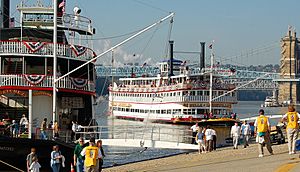
Cincinnati's location on the Ohio River made it a crossroads. It traded with Southern states where slavery was legal. At the same time, many Black people were moving to Ohio, a free state. This led to disagreements between people who supported slavery and those who wanted to end it. In the past, Cincinnati was sometimes called "a Southern city on free soil."
Many German immigrants came to Cincinnati, especially after 1848. By 1900, over 60% of the population had German roots. The city still celebrates its immigrant heritage. Events like Oktoberfest Zinzinnati and Bockfest honor German traditions. The Taste of Cincinnati features local restaurants.
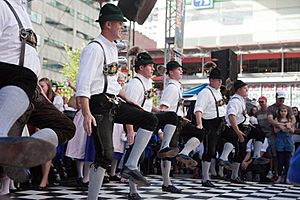
Cincinnati also has a strong Jewish community. Many Jewish people from England and Germany helped build this community. A key leader, Isaac M. Wise, helped create Reform Judaism in the United States.
Museums to Explore
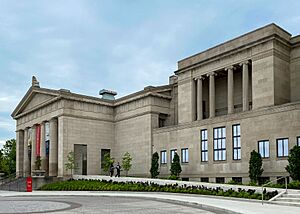
The Cincinnati Art Museum is in the Eden Park neighborhood. It was founded in 1881 and was the first art museum built for its purpose west of the Appalachian Mountains. It has over 67,000 artworks covering 6,000 years of history. The Contemporary Arts Center started in 1939. It was one of the first places in the country to focus on modern art. The Art Academy of Cincinnati also has public art galleries.
The city's Cincinnati Museum Center is located in the Cincinnati Union Terminal. This complex includes the Cincinnati History Museum, the Museum of Natural History & Science, and the Duke Energy Children's Museum. The National Underground Railroad Freedom Center opened in 2004. It teaches about the Underground Railroad and Cincinnati's role in helping enslaved people escape to freedom. You can also visit the childhood home of U.S. president William Howard Taft.
The American Sign Museum is a fun place to visit. It has over 200 old signs from the late 1800s to the 1970s.
Music Scene
Cincinnati hosts many music events. These include the Cincinnati May Festival and the Bunbury Music Festival. In 2012, Cincinnati hosted the World Choir Games, with the motto "Cincinnati, the City that Sings!"
Many famous musicians and singers are from Cincinnati. These include Doris Day, Rosemary Clooney, and Bootsy Collins. The band Walk the Moon is also from here.
The Cincinnati May Festival Chorus is a choir that has been around since 1880. The city is home to the Cincinnati Symphony Orchestra, Cincinnati Opera, and Cincinnati Ballet. The Cincinnati Music Hall was built to be the home of the May Festival.
Cincinnati was also an important place for early music recordings. King Records helped start the career of James Brown. Louis Armstrong made some of his first recordings near Cincinnati.
Theater and Shows
Professional theater has been in Cincinnati since the 1800s. The city has many theater groups, like Ensemble Theatre Cincinnati and Cincinnati Shakespeare Company. The Cincinnati Playhouse in the Park puts on new plays. The Aronoff Center hosts big touring Broadway shows every year.
Cincinnati also has community theaters. The Showboat Majestic is the last remaining showboat in the United States.
The Cincinnati Opera and the University of Cincinnati College-Conservatory of Music work together on a project called Opera Fusion: New Works. This program helps composers and writers create new operas.
Movies and Books
Many movies have been filmed in Cincinnati. A Rage in Harlem was filmed entirely in the Over-the-Rhine neighborhood. Other movies filmed partly here include Rain Man, Little Man Tate, and Carol. The TV show WKRP in Cincinnati was set in the city, and its opening credits showed the skyline.
The "Hollows" book series by Kim Harrison takes place in Cincinnati. The "Kit Kittredge" books by American Girl are also set in the city.
Local Food
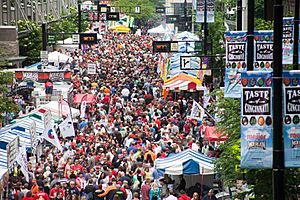
Cincinnati has many unique foods. Some local favorites that you can find in grocery stores are Frisch's Big Boy, Graeter's ice cream, and LaRosa's Pizzeria. Glier's goetta is a popular local food.
The Maisonette was a very famous restaurant in Cincinnati. It had five stars for 41 years until it closed in 2005.
Arnold's Bar and Grill is one of the oldest and most famous bars in the U.S. It has won many awards.
The Filet-O-Fish sandwich was created in 1962 by Lou Groen. He owned the first McDonald's in Cincinnati. He made it for Catholic customers who did not eat meat on Fridays.
Other local treats include opera creams and nectar soda. These are served at ice cream parlors like Graeter's. Grippo's and Pringles potato chips also started in this area.
Cincinnati Chili
Cincinnati chili is the area's most famous food. It is a spiced sauce served over noodles. It is usually topped with cheese, and often with diced onions or beans. Different chili parlors have their own recipes. Some popular ones are Skyline Chili, Gold Star Chili, and Dixie Chili and Deli. It was first made by immigrants from Macedonia in the 1920s. Cincinnati is known as the "Chili Capital of America" because it has so many chili restaurants.
Goetta
Goetta is a type of meat and grain sausage or mush. It is made mostly from ground pork (or pork and beef), oats, and spices. It is a popular breakfast food in Cincinnati.
Mock Turtle Soup
Mock turtle soup became popular in Cincinnati because of German immigrants in the late 1800s. Today, Cincinnati-style mock turtle soup is made with ground beef, hard-boiled eggs, and ketchup. Worthmore, a company in Cincinnati, has been making canned mock turtle soup since 1918.
Local Accent
People in Cincinnati generally speak with a General American accent. However, some local features are similar to accents in northern New Jersey. There is also some influence from the Southern American accent found in Kentucky. Sometimes, people in Cincinnati say "please" when they want someone to repeat something. This comes from the German word bitte, which can mean "please" or "pardon me."
Sports in Cincinnati
Cincinnati has three major league sports teams. These are the Cincinnati Reds (baseball), the Cincinnati Bengals (football), and FC Cincinnati (soccer). The city also has minor league teams and college sports teams. WalletHub has ranked Cincinnati as the 12th best sports city.
On Major League Baseball Opening Day, Cincinnati has a special tradition. It holds the "traditional opener" for baseball each year. Many children even skip school for it, and it feels like a holiday. The Cincinnati Reds have won five World Series titles. They had a very successful team in the mid-1970s, known as The Big Red Machine.
The Bengals have played in three Super Bowls but have not yet won a championship. They have strong rivalries with the Cleveland Browns and Pittsburgh Steelers. When the Bengals play the Carolina Panthers, their game is sometimes called the "Queen City Bowl." This is because both Cincinnati and Charlotte (the Panthers' home) are known as the Queen City.
FC Cincinnati is a soccer team that plays in Major League Soccer. They joined MLS in 2019. Their home stadium, TQL Stadium, opened in 2021.
Cincinnati is also home to two men's college basketball teams: the Cincinnati Bearcats and Xavier Musketeers. They have a big rivalry called the Crosstown Shootout. The Bearcats have won two national championships.
The Flying Pig Marathon is a yearly running event that attracts many runners. It is a qualifying race for the Boston Marathon.
The Cincinnati Open is a big international tennis tournament. It has been held near Cincinnati since 1899.
The Cincinnati Cyclones are a minor league ice hockey team. They play at the Heritage Bank Center. They won the Kelly Cup Finals in 2010.
The table below shows sports teams in the Cincinnati area that have more than 5,000 fans per game:
| Club | Sport | Founded | League | Venue | Avg attend | Ref |
|---|---|---|---|---|---|---|
| Cincinnati Reds | Baseball | 1882 | Major League Baseball | Great American Ball Park | 25,164 | |
| Cincinnati Bearcats | Football | 1885 | NCAA Division I | Nippert Stadium | 33,871 | |
| Cincinnati Bearcats | Basketball | 1901 | NCAA Division I | Fifth Third Arena | 9,415 | |
| Xavier Musketeers | Basketball | 1920 | NCAA Division I | Cintas Center | 10,281 | |
| Cincinnati Bengals | Football | 1968 | National Football League | Paycor Stadium | 66,247 | |
| Cincinnati Cyclones | Ice hockey | 1990 | ECHL | Heritage Bank Center | 6,633 | |
| FC Cincinnati | Soccer | 2015 | Major League Soccer | TQL Stadium | 25,265 |
Parks and Fun Activities
The Cincinnati Park Board takes care of all the city parks. It was started in 1911. Today, it manages over 5,000 acres (2,000 ha) of park space. Famous parks include Spring Grove Cemetery and Arboretum, Eden Park, and Mount Storm Park. These were designed by a landscape architect from Prussia named Adolph Strauch. The city also has several public golf courses.
Fountain Square is a public square and a popular spot for events in downtown Cincinnati. It was updated in 2006. Cincinnati is located along 22 miles (35 km) of the Ohio River. This river plays a big part in the city's life.
The Cincinnati Zoo & Botanical Garden in Avondale is the second-oldest zoo in the United States. It became a National Historic Landmark in 1987. The zoo has over 500 different kinds of animals and 3,000 plant species. It is known for its successful breeding programs. The zoo is often called one of the best in the country.
Education in Cincinnati
Schools for Kids
Cincinnati Public Schools (CPS) has 18 high schools. CPS is one of the largest school systems in Ohio. It includes public Montessori schools, like Clark Montessori, which was the first public Montessori high school in the U.S. The top-rated school in CPS is Walnut Hills High School. It offers many advanced courses. Cincinnati is also home to the School for Creative and Performing Arts. This is the first K-12 arts school in the country.
The Roman Catholic Archdiocese of Cincinnati runs 16 high schools in Cincinnati. Many of these are single-sex, meaning they are either all-girls or all-boys schools.
Colleges and Universities
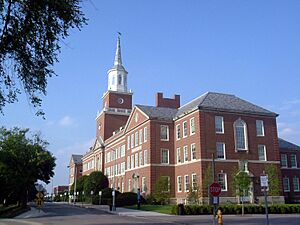
The University of Cincinnati is a public research university. It was founded in 1819. It is the oldest higher education school in Cincinnati. With over 50,000 students, it is the second-largest university in Ohio. It is known for its programs in architecture, engineering, music, and nursing. Its main campus is in the Heights and Corryville neighborhoods.
Xavier University is a Roman Catholic college. It focuses on liberal arts education. Cincinnati State Technical and Community College offers technical and community college programs. The Art Academy of Cincinnati was founded in 1869. Hebrew Union College – Jewish Institute of Religion (HUC-JIR) is a seminary for training Reform rabbis.
Libraries for Everyone
Cincinnati has a large library system. The Cincinnati and Hamilton County Public Library system was the second largest in the U.S. by the number of books and other items it held in 2016.
Media and News
Newspapers and Magazines
Cincinnati's daily newspaper is The Cincinnati Enquirer, which started in 1841. The city also has other publications. These include the free weekly magazine CityBeat and the African American newspaper The Cincinnati Herald.
TV Stations

Cincinnati is the 36th largest TV market in the U.S. There are 12 TV stations that broadcast from Cincinnati. Major stations include WLWT (NBC), WCPO-TV (ABC), WKRC-TV (CBS), and WXIX-TV (Fox). WCET (channel 48) is the oldest public television station in the United States.
Radio Stations
Cincinnati is the 33rd largest radio market in the U.S. It has about 1.8 million listeners. Major radio companies here include iHeartMedia. WLW and WCKY are powerful radio stations that can be heard across much of the eastern U.S. at night. Cincinnati Public Radio includes WVXU for news and WGUC for classical music.
Getting Around Cincinnati
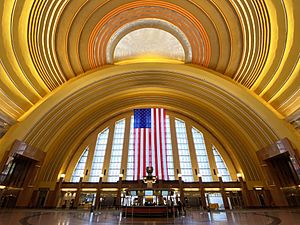
Most people in Cincinnati travel by car. However, the use of bicycles has grown quickly. The city has more households without a car than the national average.
Cincinnati has wanted a light rail system for a long time. In 1917, citizens voted to build a Cincinnati Subway. The plan was for a 16-mile (26 km) loop around the city. However, World War I and rising costs stopped the project. The subway was never finished.
Public Transportation
The Connector streetcar line opened in Downtown and Over-the-Rhine in 2016. It runs over the unfinished subway tunnels. The streetcar has over 3.5 miles (5.6 km) of track. In 2022, over 846,000 people rode it.
Cincinnati is served by bus systems: the Southwest Ohio Regional Transit Authority (SORTA) and the Transit Authority of Northern Kentucky (TANK). SORTA buses are called "Metro" by locals.
The city also has many public staircases, called the Steps of Cincinnati. There are about 400 stairways that help people walk up and down the city's hills. They also offer great views.
Amtrak's Cardinal train stops at Cincinnati Union Terminal. This train travels between Chicago and New York City three times a week.
Roads and Highways
Cincinnati has a lot of bus traffic. Several companies offer bus trips within the Midwest and beyond. The city has a beltway, Interstate 275, which is one of the longest beltways in the U.S. It is also served by major highways like Interstate 71, Interstate 74, and Interstate 75.
Airports
The city is served by Cincinnati/Northern Kentucky International Airport (IATA: CVG). It is located in Hebron, Kentucky. This airport is a hub for cargo flights for Amazon Air and DHL Aviation. It offers flights to over 50 places in North America and to cities in Europe like Paris and London. CVG is the 6th busiest airport in the U.S. for cargo.
Another airport is Cincinnati Municipal Lunken Airport (IATA: LUK). It has daily commercial charter flights.
Sister Cities
Cincinnati has several sister cities around the world:
 Amman, Jordan
Amman, Jordan Gifu, Japan
Gifu, Japan Harare, Zimbabwe
Harare, Zimbabwe Kharkiv, Ukraine
Kharkiv, Ukraine Liuzhou, China
Liuzhou, China Munich, Germany
Munich, Germany Mysore, India
Mysore, India Nancy, France
Nancy, France New Taipei, Taiwan
New Taipei, Taiwan
See also
 In Spanish: Cincinnati para niños
In Spanish: Cincinnati para niños





